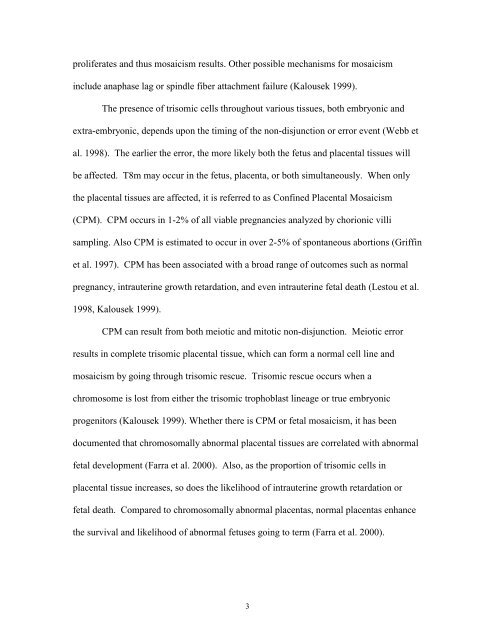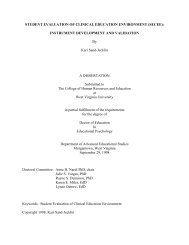TRISOMY 8 MOSAICISM: CELL CYCLE KINETICS AND ...
TRISOMY 8 MOSAICISM: CELL CYCLE KINETICS AND ...
TRISOMY 8 MOSAICISM: CELL CYCLE KINETICS AND ...
Create successful ePaper yourself
Turn your PDF publications into a flip-book with our unique Google optimized e-Paper software.
proliferates and thus mosaicism results. Other possible mechanisms for mosaicism<br />
include anaphase lag or spindle fiber attachment failure (Kalousek 1999).<br />
The presence of trisomic cells throughout various tissues, both embryonic and<br />
extra-embryonic, depends upon the timing of the non-disjunction or error event (Webb et<br />
al. 1998). The earlier the error, the more likely both the fetus and placental tissues will<br />
be affected. T8m may occur in the fetus, placenta, or both simultaneously. When only<br />
the placental tissues are affected, it is referred to as Confined Placental Mosaicism<br />
(CPM). CPM occurs in 1-2% of all viable pregnancies analyzed by chorionic villi<br />
sampling. Also CPM is estimated to occur in over 2-5% of spontaneous abortions (Griffin<br />
et al. 1997). CPM has been associated with a broad range of outcomes such as normal<br />
pregnancy, intrauterine growth retardation, and even intrauterine fetal death (Lestou et al.<br />
1998, Kalousek 1999).<br />
CPM can result from both meiotic and mitotic non-disjunction. Meiotic error<br />
results in complete trisomic placental tissue, which can form a normal cell line and<br />
mosaicism by going through trisomic rescue. Trisomic rescue occurs when a<br />
chromosome is lost from either the trisomic trophoblast lineage or true embryonic<br />
progenitors (Kalousek 1999). Whether there is CPM or fetal mosaicism, it has been<br />
documented that chromosomally abnormal placental tissues are correlated with abnormal<br />
fetal development (Farra et al. 2000). Also, as the proportion of trisomic cells in<br />
placental tissue increases, so does the likelihood of intrauterine growth retardation or<br />
fetal death. Compared to chromosomally abnormal placentas, normal placentas enhance<br />
the survival and likelihood of abnormal fetuses going to term (Farra et al. 2000).<br />
3












